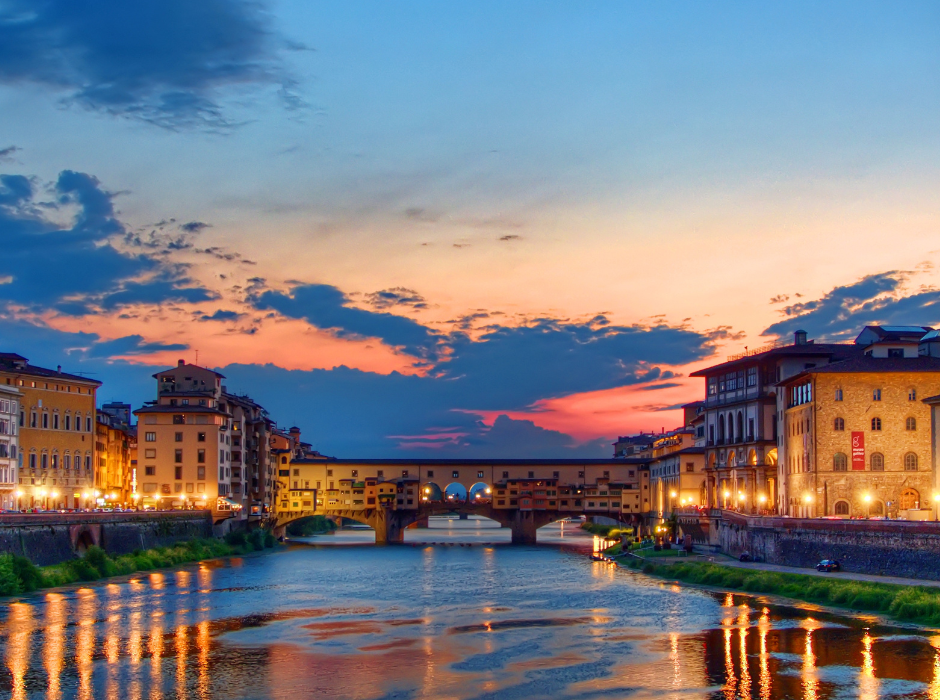Ponte Vecchio: A Symbol of Florence
Ponte Vecchio is one of the most iconic and fascinating monuments in Florence. It is not only an engineering masterpiece but also a symbol of the city and Florentine culture.
A Bridge Between Two Banks
Ponte Vecchio, the oldest bridge in Florence, connects the two banks of the Arno, standing between the two parts of the city that Florentines call ‘diquaddarno’ and ‘diladdarno.’ On one side lies the postcard-perfect historic center with the Duomo and Piazza della Signoria, while on the other extends the Oltrarno, one of the most authentic areas of the city, where artisan workshops intertwine with innovative restaurants and hidden gardens.
A History Spanning Seven Centuries
With nearly 700 years of history, Ponte Vecchio has much to tell. From its medieval origins to Renaissance renovations up to the present day, this pedestrian bridge is crossed daily by thousands of people. Likely dating back to Roman times, the original structure was destroyed by a flood of the Arno in 1117 and subsequently rebuilt multiple times. The current appearance dates back to 1345 when it was reconstructed in stone by architect Taddeo Gaddi under the supervision of Florence’s rulers.
The Vasari Corridor: A Secret Passage
In 1565, architect Giorgio Vasari built the “Vasari Corridor” for Cosimo I, an elevated passage connecting Palazzo Vecchio with Palazzo Pitti. This corridor, about 760 meters long, was completed in just five months to allow the Medici family to move safely between their residences without mingling with the crowd. The passage, which crosses the bridge’s shops, represented a significant architectural innovation of the time.
A Commercial Hub Over the River
Over the centuries, the bridge has taken on different functions and hosted various businesses. Originally, the shops were occupied by butchers, fishmongers, and artisans, but in the 15th century, under Medici rule, they were replaced by goldsmiths and jewelers, a tradition that continues to this day. The decision to allocate the bridge to these businesses was made to boost the city’s economy and maintain control over commercial activities.
A Rare Inhabited Bridge
Ponte Vecchio, the oldest bridge in Florence, is one of the few “inhabited bridges” still in existence worldwide—bridges that permanently host commercial or residential structures. Its unique architecture is distinguished by three arches, with the central one higher than the others. The structure, built in pietra serena, gives the bridge its characteristic gray color and ensures its stability and durability over time. Constructing the bridge in stone instead of wood allowed it to withstand the Arno’s floods and become a strategic point for trade between the river’s two banks.
The Bridge’s Shops: Between History and Tradition
The shops that adorn the bridge, now mostly occupied by jewelers and artisans, once housed greengrocers and butchers. In the 16th century, city authorities required butchers to move to the bridge to keep the central streets clean and prevent meat waste from being dumped in inhabited areas. With the construction of the Vasari Corridor, butcher shops were deemed inappropriate, and in 1593, they were evicted to make way for goldsmiths, who have since made the bridge famous for Florentine jewelry craftsmanship. To honor this tradition, a fountain featuring the bust of Benvenuto Cellini, the greatest Florentine goldsmith, sculpted by Raffaello Romanelli, was placed in the bridge’s central terrace.
World War II and the Bridge’s Survival
One of the most significant historical events related to Ponte Vecchio was its survival during World War II. In 1944, during the German retreat, all the bridges in Florence were destroyed to slow the Allied advance, but Ponte Vecchio was miraculously spared. The reasons behind this decision are still debated today: some argue that the Germans wanted to preserve such an important city symbol, while others believe that Florentines themselves prevented its destruction.
A Bridge That Withstands Time
Thanks to its resilience, Ponte Vecchio remained intact, and its survival has only increased its symbolic value. After the war, the bridge underwent restorations to repair damaged parts, maintaining its original appearance unchanged.
A Timeless Tourist Attraction
Today, Ponte Vecchio, the oldest bridge in Florence, is one of the city’s main tourist attractions, visited by millions of people from around the world every year. Its shops have become a must-visit for lovers of jewelry and high-quality craftsmanship. Walking across Ponte Vecchio means taking a journey through time and immersing oneself in one of the city’s most romantic places.
A National Artistic Heritage
Recognized as a national artistic heritage in 1901 by the General Directorate of Antiquities and Fine Arts, Ponte Vecchio continues to stand as a living testimony to Florence’s history and identity. It is not just a bridge, but a piece of history that still tells the tale of the past and the beauty of a timeless city.
Foto Articolo: Web roialty free

